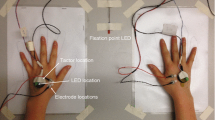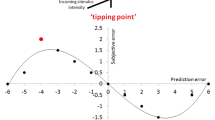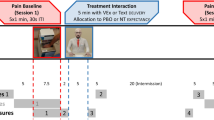Abstract
While stimulus intensity obviously affects degree of pain responding, presentation order effects of stimuli of different intensities on acute pain responses are under-researched. The present study examined the effects of manipulating presentation order of lower and higher pain stimulus intensity. Using 96 undergraduates, this investigation employed a 2 × 2 mixed research design, with pain stimulus sequence as a between-subjects variable and pain stimulus trial as a repeated measure. When the greater pain stimulus intensity was presented last, verbal report of pain was higher. Also, performance of a cognitive task was interrupted the least when the lower stimulus intensity was presented last. Heart rate, however, was highest when the greater stimulus intensity was presented first, and pain tolerance was greatest when the lower stimulus intensity was presented first. Results are discussed in relation to adaptation-level effects, and implications for pain experienced in clinical settings are suggested.




Similar content being viewed by others
Notes
The primary interest of the study was differences when experiencing different sequences of stimulus intensity (not differences from baseline); t-tests revealed participants in the two sequence groups did not differ on baseline measures, and the results of the planned 2 × 2 ANOVA tests are presented for clarity and simplicity. It should be noted, though, that with analyses including baseline values as another repeated measure time point or as a covariate, a similar pattern of results emerged.
References
Allen, M. T., & Crowell, M. D. (1990). The effects of paced respiration on cardiopulmonary responses to laboratory stressors. Journal of Psychophysiology, 4, 357–368.
Ariely, D. (1998). Combining experiences over time: The effects of duration, intensity changes, and on-line measurements on retrospective pain evaluations. Journal of Behavioral Decision Making, 11, 19–45. doi:10.1002/(SICI)1099-0771(199803)11:1<19::AID-BDM277>3.0.CO;2-B.
Backs, R. W., da Silva, S. P., & Han, K. (2005). A comparison of younger and older adults’ self-assessment manikin ratings of affective pictures. Experimental Aging Research, 31, 421–440. doi:10.1080/03610730500206808.
Badia, P., & Harley, J. P. (1970). Habituation and temporal conditioning as related to shock intensity and its judgment. Journal of Experimental Psychology, 84, 534–536. doi:10.1037/h0029288.
Bolles, R. C., & Fanselow, M. S. (1980). Perceptual-defensive-recuperative model of fear and pain. The Behavioral and Brain Sciences, 3, 291–323.
Boureau, F., Luu, M., & Doubrère, J. F. (1991). Study of experimental pain measures and nociceptive reflex in chronic pain patients and normal subjects. Pain, 44, 131–138. doi:10.1016/0304-3959(91)90126-I.
Bradley, M. M., & Lang, P. J. (1994). Measuring emotion: The self-assessment manikin and the semantic differential. Journal of Behavior Therapy and Experimental Psychiatry, 25, 49–59. doi:10.1016/0005-7916(94)90063-9.
Carter, L. E., McNeil, D. W., Vowles, K. E., Sorrell, J. T., Turk, C. L., Ries, B. J., et al. (2002). Effects of emotion on pain reports, tolerance and physiology. Pain Research & Management, 7, 21–30.
Christenfeld, N. (1997). Memory for pain and delayed effects of distraction. Health Psychology, 16, 327–330. doi:10.1037/0278-6133.16.4.327.
Cleeland, C. S. (1986). How to treat a ‘construct.’. Journal of Pain and Symptom Management, 1, 161–162. doi:10.1016/S0885-3924(86)80067-7.
Condes-Lara, M., Calvo, J. M., & Fernandez-Guardiola, A. (1981). Habituation to bearable experimental pain elicited by tooth pulp electrical stimulation. Pain, 11, 185–200. doi:10.1016/0304-3959(81)90004-X.
Cook, E. W., I. I. I., Atkinson, L., & Lang, K. G. (1987). Stimulus control and data acquisition for IBM PC’s and compatibles. Psychophysiology, 24, 726–727. doi:10.1111/j.1469-8986.1987.tb00361.x.
Dar, R., Ariely, D., & Frenk, H. (1995). The effect of past-injury on pain threshold and tolerance. Pain, 60, 189–193. doi:10.1016/0304-3959(94)00108-Q.
Dougher, M. J., Goldstein, D., & Leight, K. A. (1987). Induced anxiety and pain. Journal of Anxiety Disorders, 1, 259–264. doi:10.1016/0887-6185(87)90030-2.
Eccleston, C. (1994). Chronic pain and attention: A cognitive approach. The British Journal of Clinical Psychology, 33, 535–547.
Eccleston, C. (1995). Chronic pain and distraction: An experimental investigation into the role of sustained and shifting attention in the processing of chronic persistent pain. Behaviour Research and Therapy, 33, 391–405. doi:10.1016/0005-7967(94)00057-Q.
Eccleston, C., & Crombez, G. (1999). Pain demands attention: A cognitive-affective model of the interruptive function of pain. Psychological Bulletin, 125, 356–366. doi:10.1037/0033-2909.125.3.356.
Ernst, A. A., Gershoff, L., Miller, P., Tilden, E., & Weiss, S. J. (2003). Warmed versus room temperature saline for laceration irrigation: A randomized clinical trial. Southern Medical Journal, 96, 436–439. doi:10.1097/01.SMJ.0000056657.63336.6C.
Ernst, A. A., Takakuwa, K. M., Letner, C., & Weiss, S. J. (1999). Warmed versus room temperature saline solution for ear irrigation: A randomized clinical trial. Annals of Emergency Medicine, 34, 347–350. doi:10.1016/S0196-0644(99)70129-0.
Ernst, A. A., Thomson, T., Haynes, M. L., & Weiss, S. J. (1998). Warmed versus room temperature saline solution for ocular irrigation: A randomized clinical trial. Annals of Emergency Medicine, 32, 676–679. doi:10.1016/S0196-0644(98)70066-6.
Feldner, M. T., & Hekmat, H. (2001). Perceived control over anxiety-related events as a predictor of pain behaviors in a cold pressor task. Journal of Behavior Therapy and Experimental Psychiatry, 32, 191–202. doi:10.1016/S0005-7916(01)00034-9.
Forgione, A. G., & Barber, T. X. (1971). A strain gauge pain simulator. Psychophysiology, 8, 102–106. doi:10.1111/j.1469-8986.1971.tb00441.x.
Gatchel, R. J., & Epker, J. (1999). Psychosocial predictors of chronic pain and response to treatment. In R. J. Gatchel & D. C. Turk (Eds.), Psychosocial factors in pain: Critical perspectives (pp. 412–434). New York: Guilford Press.
Jennings, P. D., McGinnis, D., Lovejoy, S., & Stirling, J. (2000). Valence and arousal ratings for Velten mood induction statements. Motivation and Emotion, 24, 285–297. doi:10.1023/A:1010745016868.
Kaakko, T., Horn, M. T., Weinstein, P., Kaufman, E., Leggott, P., & Coldwell, S. E. (2003). The influence of sequence of impressions on children’s anxiety and discomfort. Pediatric Dentistry, 24, 357–364.
Kahneman, D., Fredrickson, B. L., Schreiber, C. A., & Redelmeier, D. A. (1993). When more pain is preferred to less: Adding a better end. Psychological Science, 4, 401–405. doi:10.1111/j.1467-9280.1993.tb00589.x.
Landy, S., Rice, K., & Lobo, B. (2004). Central sensitization and cutaneous allodynia in migraine. CNS Drugs, 18, 337–342. doi:10.2165/00023210-200418060-00001.
Lang, P. J. (1968). Fear reduction and fear behavior: Problems in treating a construct. In J. M. Schlien (Ed.), Research in psychotherapy (Vol. 3, pp. 90–102). Washington, DC: American Psychological Association.
Lang, P. J. (1980). Behavioral treatment and bio-behavioral assessment: Computer applications. In J. B. Sidowski, J. H. Johnson, & T. A. Williams (Eds.), Technology in mental health care delivery systems (pp. 119–137). Norwood, NJ: Ablex Publishing.
Larkin, K. T. (2006). Physiological assessment. In M. Hersen (Ed.), Clinician’s handbook of adult behavioral assessment (pp. 165–185). Burlington, MA: Academic Press.
Lautenbacher, S., Prager, M., & Rollman, G. B. (2007). Pain additivity, diffuse noxious inhibitory controls, and attention: A functional measurement analysis. Somatosensory and Motor Research, 24, 189–201. doi:10.1080/08990220701637638.
Marcus, D. A. (2003). Central sensitization: An important factor in the pathogenesis of chronic headache. Headache and Pain: Diagnostic Challenges. Current Therapeutics, 14, 19–23.
McCaul, K. D., Monson, N., & Maki, R. H. (1992). Does distraction reduce pain-produced distress among college students? Health Psychology, 11, 210–217. doi:10.1037/0278-6133.11.4.210.
McCaul, K. D., Solomon, S., & Holmes, D. S. (1979). Effects of paced respiration and expectations on physiological and psychological responses to threat. Journal of Personality and Social Psychology, 37, 564–571. doi:10.1037/0022-3514.37.4.564.
McNeil, D. W., & Brunetti, D. G. (1992). Pain and fear: A bioinformational perspective on responsivity to imagery. Behaviour Research and Therapy, 30, 513–520. doi:10.1016/0005-7967(92)90035-F.
Mehrabian, A., & Russell, J. A. (1974). An approach to environmental psychology. Cambridge, MA: MIT Press.
Osgood, C. E., Suci, G. J., & Tannenbaum, P. H. (1957). The measurement of meaning. Urbana, IL: University of Illinois Press.
Peters, M. L., & Schmidt, A. J. (1991). Psychophysiological responses to repeated acute pain stimulation in chronic low back pain patients. Journal of Psychosomatic Research, 35, 59–74. doi:10.1016/0022-3999(91)90007-B.
Peters, M. L., Schmidt, A. J. M., Van den Hout, M. A., Koopmans, R., & Sluijter, M. E. (1992). Chronic back pain, acute postoperative pain and the activation of diffuse noxious inhibitory controls (DNIC). Pain, 50, 177–187. doi:10.1016/0304-3959(92)90159-9.
Price, D. D., Bush, F. M., Long, S., & Harkin, S. W. (1994). A comparison of pain measurement characteristics of mechanical visual analogue and simple numerical rating scales. Pain, 56, 217–226. doi:10.1016/0304-3959(94)90097-3.
Prkachin, K. M., Mass, H., & Mercer, S. R. (2004). Effects of exposure on perception of pain expression. Pain, 111, 8–12. doi:10.1016/j.pain.2004.03.027.
Rachman, S., & Hodgson, R. (1974). Synchrony and desynchrony in fear and avoidance. Behaviour Research and Therapy, 12, 311–318. doi:10.1016/0005-7967(74)90005-9.
Rachman, S., & Lopatka, C. (1986). Do fears summate?-III. Behaviour Research and Therapy, 24, 653–660. doi:10.1016/0005-7967(86)90060-4.
Rainwater, A. J., & McNeil, D. W. (1991). Reinventing the algometer: Synopsis of the literature and presentation of a reliable, inexpensive model. Behavior Research Methods, Instruments, & Computers, 23, 486–492.
Rollman, G. B. (1979). Signal detection theory pain measures: Empirical validation studies and adaptation-level effects. Pain, 6, 9–21. doi:10.1016/0304-3959(79)90136-2.
Rollman, G. B. (1989). Measurement of pain in fibromyalgia in the clinic and laboratory. The Journal of Rheumatology, 19, 113–119. (supplement).
Stern, R. M., Ray, W. J., & Quigley, K. S. (2001). Psychophysiological recording. New York City: Oxford University Press.
Strempel, H. (1976). Adaptive modifications of cold pain. European Journal of Applied Physiology and Occupational Physiology, 36, 19–25. doi:10.1007/BF00421630.
Treede, R. D. (1995). Peripheral acute pain mechanisms. Annals of Medicine, 27, 213–216. doi:10.3109/07853899509031961.
Treede, R. D. (1999). Transduction and transmission properties of primary nociceptive afferents. Russian Journal of Phsyiology, 85, 205–211.
Tse, M. M. Y., Chan, M. F., & Benzie, I. F. F. (2005). The effects of music therapy on postoperative pain, heart rate, systolic blood pressure, and analgesic use following nasal surgery. Journal of Pain & Palliative Care Pharmacotherapy, 19, 21–29. doi:10.1300/J354v19n03_05.
Tversky, A., & Kahneman, D. (1974). Judgment under uncertainty: Heuristics and biases. Science, 185, 1124–1131. doi:10.1126/science.185.4157.1124.
Vowles, K. E., McNeil, D. W., Sorrell, J. T., & Lawrence, S. M. (2006). Fear and pain: Investigating the interaction between aversive states. Journal of Abnormal Psychology, 115, 821–833. doi:10.1037/0021-843X.115.4.821.
Williams, D. A. (1999). Acute pain (with special emphasis on painful medical procedures). In R. J. Gatchel & D. C. Turk (Eds.), Psychosocial factors in pain: Critical perspectives (pp. 151–163). New York: Guilford Press.
Willis, W. D., & Westlund, K. N. (1997). Neuroanatomy of the pain system and of the pathways that modulate pain. Journal of Clinical Neurophysiology, 14, 2–31. doi:10.1097/00004691-199701000-00002.
Wilson, J. F., Brockopp, G. W., Kryst, S., Steger, H., & Witt, W. O. (1992). Medical students’ attitudes toward pain before and after a brief course on pain. Pain, 50, 251–256. doi:10.1016/0304-3959(92)90028-A.
Wolff, B. B. (1983). Laboratory methods of pain measurement. In R. Melzack (Ed.), Pain measurement and assessment (pp. 7–13). New York: Raven Press.
Zvolensky, M. J., Eifert, G. H., Lejuez, C. W., & McNeil, D. W. (1999). The effects of offset control over 20% carbon dioxide-enriched air over on anxious responding. Journal of Abnormal Psychology, 108, 624–632. doi:10.1037/0021-843X.108.4.624.
Zvolensky, M. J., Lejuez, C. W., & Eifert, G. H. (1998). The role of offset control in anxious responding: An experimental test using repeated administrations of 20% carbon dioxide-enriched air. Behavior Therapy, 29, 193–209. doi:10.1016/S0005-7894(98)80002-6.
Acknowledgments
This paper is based on a master’s thesis by the first author, supervised by the second author. This research was presented at the 2007 meeting of the Association for Behavioral and Cognitive Therapies, Philadelphia, PA. This study was conducted in the Anxiety, Psychophysiology, and Pain Research Laboratory in the Department of Psychology at West Virginia University.
The authors thank the following research assistants in that laboratory for their assistance in data collection: Andrea Ramsey, Kevin Mealy, Danielle Hamer, and Vanesah Noechel. This research was made possible through funding from the West Virginia University Department of Psychology Alumni Fund.
Author information
Authors and Affiliations
Corresponding author
Rights and permissions
About this article
Cite this article
Kyle, B.N., McNeil, D.W., Weinstein, B.J. et al. Interaction of intensity and order regarding painful events. J Behav Med 32, 360–370 (2009). https://doi.org/10.1007/s10865-009-9210-y
Received:
Accepted:
Published:
Issue Date:
DOI: https://doi.org/10.1007/s10865-009-9210-y




